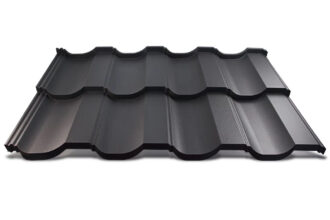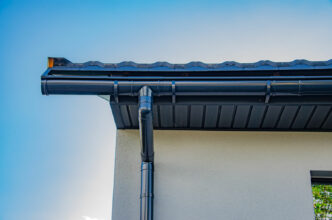The gutters are primarily responsible for the drainage of the roof surface. To operate efficiently and reliably, the gutter and piping system must be correctly fitted to the roof. In this context, the gutters’ number, size and diameter are crucial to divert the water away from the slope. Find out how to choose the right guttering for your roof surface!
Effective roof area – what is it?
The effective roof area (EPD) usually differs from the actual roof area because it considers the complex shapes of roof tiles and additional elements such as chimneys, skylights or antennas. Calculating the effective area of the roof is essential to determine the amount of material needed to cover the roof, as well as the appropriate type of gutters and downpipes.
The EPD is determined by taking detailed measurements to determine the shape of the roof and any ancillary elements. It is calculated using a formula:
EPD = (W+H/2) x L
- W – indicates the horizontal distance from the corner to the ridge;
- H – determines the height of the roof;
- L – refers to the length of the roof slope at the ridge.
You can easily find intuitive calculators online to help you make the necessary calculations.
Gutter cross-section shape – does it matter?
Gutters differ not only in length but also in cross-sectional shape. In this category we differentiate:
- Semi-circular gutters – are suitable for most roof types. They have the great advantage of draining water very quickly, greatly reducing the risk of blockages. This type of gutter is also highly resistant to mechanical loads;
- Semi-elliptical gutters – suitable for medium to large roofs. These gutters are characterised by their high capacity yet compact design;
- Trapezoidal and rectangular gutters – ideal for roofs with small areas and simple shapes. They are easy to install and have large cross-sections for efficient drainage;
- Closed gutters – These have a closed shape. This provides better protection from debris and minimises the risk of ice and snow build-up. Closed gutters are often fitted with a rainwater drainage system to further protect the building from heavy rainfall.
How do I fit the gutters to the roof surface?
Wondering how to choose the right gutter? In addition to calculating the effective roof area (EPD), several important factors must be considered!
- Roof pitch – with a pitch of 10° or less, the maximum EPD equals the total roof area. However, for more complex designs, you will need to consider the location of the drain. If it is more than 2m from a corner, 5% of the area should be added to the EPD. If the drain is less than 2m away, add 10% of the area to the EPD.
- Actual roof area – for an area of 50m² or less, gutters should be 10cm in diameter and downpipes 7.5-8cm. On the other hand, for larger roofs (up to 100 m²), gutters with a diameter of 12.5 cm and downpipes with a diameter of 9 cm should be purchased.
- The maximum roof area – the area that can be drained using a gutter of a given cross-section and a single downpipe.
- Gutter material – the choice of the suitable material is closely related to the durability and tightness of the entire system. Steel gutters are generally considered to be the most durable and long-lasting.
- Adequate number of downpipes – even properly sized gutters can be ineffective if there are too few downpipes. This can cause water to spill out of the gutter during heavy rainfall.
What are downpipes?
Downpipes are part of the system used to drain rainwater from the roof of a building. They allow rainwater to be collected from the roof and directed to a safe place, usually a special reservoir or the rainwater drainage system.
Downpipes are very important for any building, as they allow controlled water drainage from the roof, preventing foundation flooding or waterlogging around the building. Uncontrolled drainage from the roof can lead to serious dampness, mould problems, and damage to the facade.
Downpipes come in a variety of shapes and sizes. These components are made from materials such as PVC, aluminium, copper or galvanised sheet metal. When selecting downpipes, consider factors such as the roof’s size, the slope’s angle and the average amount of rainfall per year.
Gutters – which material to choose?
Gutters can be made of many materials that vary in price, strength and also aesthetics. The most important of these include:
- Metal gutters – made of galvanised or aluminium sheet, they are characterised by high resistance to temperature extremes, mechanical damage and UV radiation;
- PVC gutters – these use a plastic material, usually in the form of polyvinyl chloride. Their main advantage is their light weight and ease of installation. However, it is important to remember that PVC gutters are less durable than, for example, metal gutters;
- Steel gutters – their great advantage is their resistance to corrosion and high resistance to the damaging effects of the weather;
- copper gutters – made of copper sheet- are durable, elegant, and expensive. An undeniable advantage of copper gutter systems is their natural protection against corrosion. Over time, a patina develops on the surface of the copper. This patina adheres permanently to the surface and protects it from moisture;
- Ceramic gutters – Made from clay or ceramic, they are very aesthetic and durable, but require professional installation and ongoing maintenance.
Are you looking for a gutter system that will last for many years and look good on your building? Trust KASKADA gutters when it comes to guttering! In the face of sudden storms and heavy downpours, which can cause a lot of damage, we have designed a deeper gutter system that drains rainwater effectively. The gutters in our range are manufactured from double-coated steel, which is aesthetically pleasing and fade-resistant. This ensures that the gutter does not deform even during rapid temperature changes!


